If you’ve attended a yoga class with me, you would have noted that Surya Namaskar (Sun Salutation) is an integral part of the routine that we practice. Typically, we practice three rounds of Surya Namaskar. In the first round, we go through the basic sequence which has the classic 12 movements. In the second and third round, we add some variations to many of the movements to emphasize stretching specific areas of the body.
In today’s post I will be discussing a sequence that will help develop upper body strength. This sequence will be integrated into the second round of the Surya Namaskar (Sun Salutation) routine.
My friend Anupam Jain has graciously agreed to be your guide for the video presentation. Hope you will enjoy practicing along with the video.
Step-by-step
Round 1
- Stand close to the top of the mat with the feet together or slightly apart but parallel to each other. As you exhale, bring the palms together in the prayer position in front of your chest.
- Inhaling, stretch your arms out in front, raise them up and arch back from the waist, pushing the hips out, legs straight. Relax your neck.
- Exhaling, fold forward, keeping the arms alongside the ears initially. In the final position, drop the hands to get close to the toes. Try to keep the knees straight, bending slightly if necessary.
- Inhaling, bring the left leg back into the lunge position, sliding the foot as far back as comfortable and place the knee on the floor. Arch back and look up, lifting your chest and chin.
- Exhaling, bring the other leg back. Lift your buttocks up, coming into an inverted "V" shape called the Adhomukha Shvanasana or Downward Facing Dog. Try to push the thighs back, heels and forehead down, tailbone lifted up and keep your shoulders back.
- Exhaling, lower the knees, chest and the chin to the floor, keeping your buttocks lifted up. This is called the "ashtanga mudra" (the gesture with eight limbs on the floor).
- Inhaling, lower the abdomen to the floor and slowly begin to lift your head, neck and chest to get into the Bhujangasana or Cobra pose. In the first round we try to lift the palms off the floor, using the upper body strength to lift the chest higher, if comfortable. Keep the shoulders rolled back.
- Exhaling, place the palms down, curl your toes under, lift the buttocks up to get back to the downward facing dog. Try to push your heels and forehead down and keep your shoulders back (same as position 5).
- Inhaling, lift the head up, bring the left foot forward and place it between your hands. Rest the other knee on the floor and look up, as in position 4.
- Exhaling, bring the other leg forward and bend down from the waist with th knees stretched straight. This is called Uttanasana (standing forward bending pose).
- Inhaling, stretch your arms in front against the ears, lift them up and back overhead and bend back slowly from the waist, as in position 2.
- Exhaling, gently come back to an upright position and bring your arms down by your sides. Relax for a few breaths before proceeding with the next round.
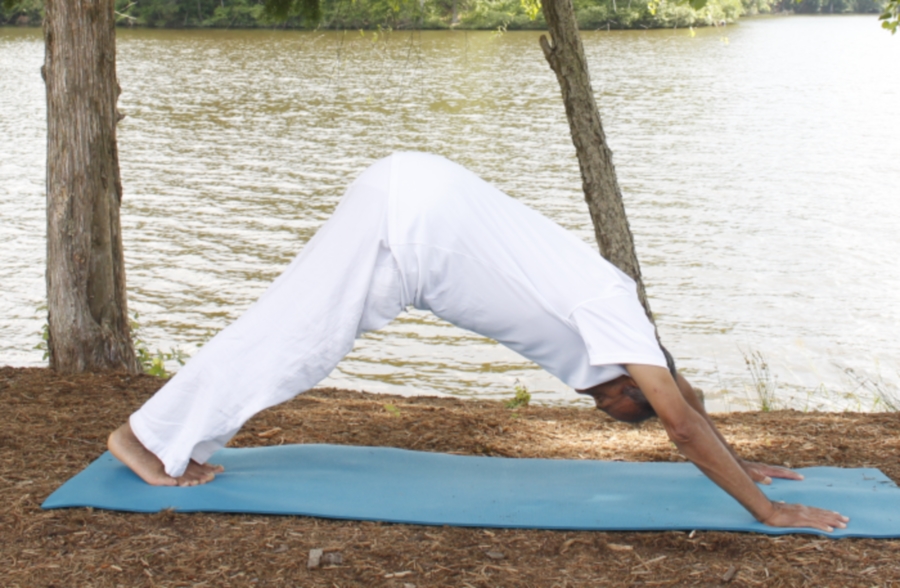
Adhomukha-shvanasana (Down Dog)
Round 2
- Stand close to the top of the mat with the feet together or slightly apart but parallel to each other. As you exhale, bring your hands in the prayer position in front of your chest.
- Inhaling, bring the arms to the side and then begin to raise them up and arch back from the waist. Pulls the hands up and push the arms back behind the ears. If comfortable, deepen the stretch by pressing the feet firmly into the ground, pushing the buttocks and thighs forward, keeping legs straight. Relax your neck.
- Exhaling, release the hands down and begin to bend forward. This time bring the hands behind the back, interlock the fingers and lift the hands up toward the ceiling when you inhale. When you exhale, make a gentle effort to drop the chest to close the gap with the thighs. Stay in this position for two extra breaths.
- Inhaling, bend the knees, place the palms on the floor right next to the feet. Now bring the right leg back into the lunge position, sliding the foot as far back as comfortable. This time we’ll keep the back leg very straight. Try to push the heel back and lift the thigh upward to keep the back leg straight and strong. Try to keep the buttocks down and chest up.
- Exhaling, bend the front knee and placing the palms on the floor, bring the other leg back. Lift your buttocks up to get into the Adhomukha Shvanasana (Downward Facing Dog). Try to push the thighs back, heels and forehead down, tailbone lifted up and keep your shoulders back.
- Balasana (Child Pose):
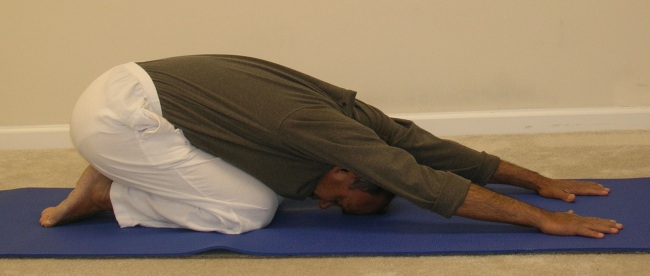
Inhaling, lower your knees to the floor and this time push the buttocks all the way back close to the heels in the child pose (Balasana). Keep the forehead on the floor and start walking your hands out in front.This is where we integrate the sequence to develop upper body strength. The child pose is the beginning and the ending pose in this sequence.
Make a note of where the hands are on the mat. Throughout the upper body routine, make sure that the hands stay ‘glued’ to the same spot on the mat.
- Bhujangasana (Cobra Pose): (Inhale) With the chin staying close to the floor, start sliding your body forward, without moving the hands, ending up in the Bhujangasana (cobra pose). In this pose, elbows are slightly bent and tucked in close to the body, and the navel is on the floor. You are making a gentle effort to raise the chest higher.
- Adhomukha Shvanasana (Downward Facing Dog): (Exhale) Pressing down with the palms and curling the toes under, slowly lift your tailbone up and get into the ‘downward facing dog’ pose. In this pose, knees and elbows are straight, your effort is to press the heels close to the floor, lift the tailbone up and lower the forehead closer to the floor.
- Urdhvamukha Shvanasana (Upward Facing Dog): (Inhale) Bending the elbows slightly, bring the forehead between the palms close to the floor, and start sliding the body forward until you get into the ‘upward facing dog’ position. In the final position, the elbows are stretched straight, palms are directly under the shoulders, toes are pointing back, tops of the feet are flat on the floor, knees are slightly lifted from the floor and the chest is pushed forward and up.
If, while sliding the body forward, it becomes uncomfortable to bend the elbows, you may keep them straight and then slide forward. Also, you may keep the knees on the floor, if needed.
- (Exhale) Once again, pushing with the palms, slide back into the ‘downward facing dog’ position. See 3 above.
- Plank Pose: (Inhale) Keeping the elbows straight, slide the body gently forward into the ‘plank’ position. In this position, the heels, buttocks and the shoulders are all in one straight line and the shoulders are lifted up and rolled back. if necessary, you may bring the knees to the floor and then try to lift the upper body up with the elbows straight.
- Chaturanga Dandasana (Four-limbed Pose): (Exhale) Slowly begin to bend the elbows, keeping them alongside the body, and bring the body down into the ‘chaturanga dandasana’ (four-limbed staff pose). Here the body is parallel to the floor with only the hands and the toes touching the floor. Alternately, you may like to keep the knees on the floor while bringing the chest parallel to the floor by bending the elbows.
- (Inhale) Lift yourself up back into the ‘plank’ pose.
- (Exhale) Lower the knees, chest and chin down to the floor with the abdomen not making contact with the floor.
- (Inhale) Slowly, lower the abdomen down to the floor and lift the head, neck and chest up into the ‘bhujangasana’ (cobra pose).
- (Exhale) Gently lower the chin to the floor and start sliding the body back into the child pose, keeping the chin as close to the floor as possible.
- The above completes one round of the upper body strengthening routine. Continue and practice as many rounds as you feel comfortable with.
- Exhaling, curl your toes under, lift the buttocks up to get back to the downward facing dog. Try to push your heels and forehead down and keep your shoulders back.
- Inhaling, lift the head up, bring the right foot forward and place it between your hands.
- This time we’ll keep the back leg very straight. Try to push the heel back and lift the thigh upward to keep the back leg straight and strong. Try to keep the buttocks down and chest up.
- Exhaling, bring the other leg forward and bend down from the waist with th knees stretched straight. This is called Uttanasana (standing forward bending pose).
- Inhaling, stretch your arms to the side, bring them up and back overhead and bend back slowly from the waist.
- Exhaling, gently come back to an upright position and bring your arms down by your sides. Relax for a few breaths.
- This completes the Surya Namaskar (Sun Salutation) routine wherein the "upper body" routine is integrated into the second round.
The "upper body" routine is an excellent routine for developing strength, flexibility and endurance in the entire upper body, including the wrists, arms and shoulders, spine and the core area. Of course, as always, take adequate precaution to keep every move within the limits of your body. With regular practice, your body will begin to feel more and more comfortable at which point you may try adding more rounds of the same routine.
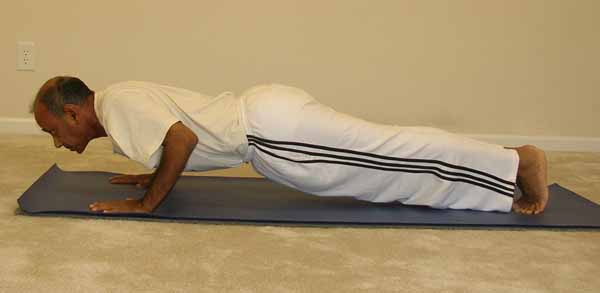
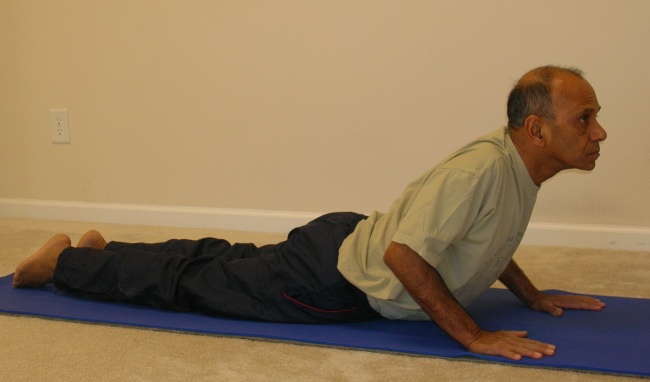
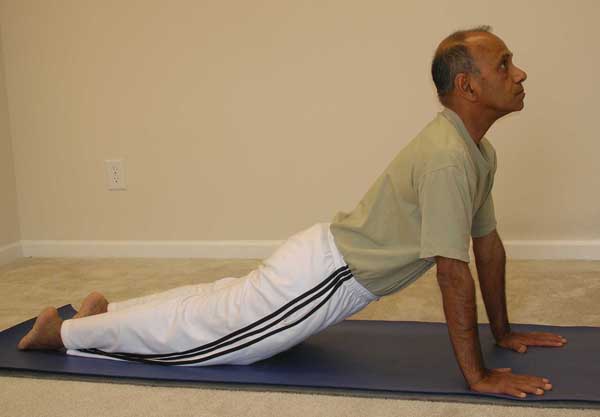
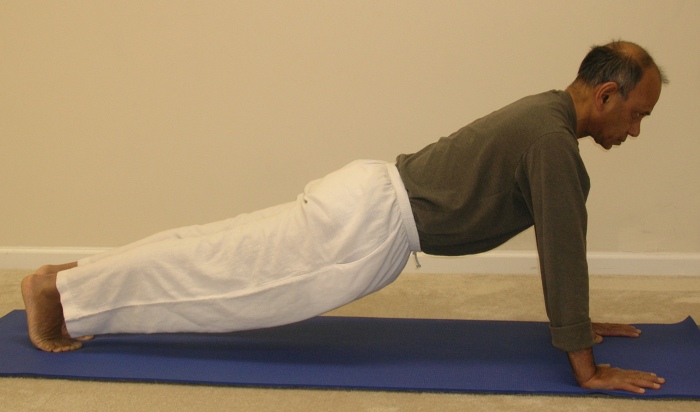
Recent Comments